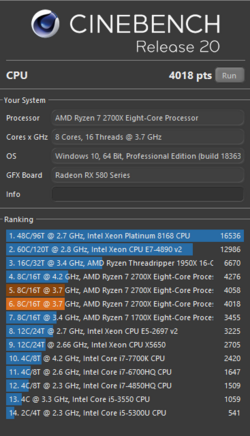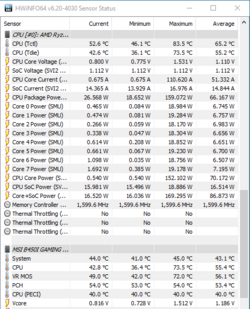- Joined
- Feb 7, 2020
- Location
- Austin, TX
I posted this over on the Gigabyte forums, but I haven't had any responses, so I thought I would try here.
====================================================================================================
I just recently put together a small form factor build in a Silverstone Mile ML06-E case with a Ryzen 5 3600 on the B450 I AORUS PRO WIFI motherboard.
Components:
- Ryzen 5 3600 @ 1.1V / 4.175GHz
- B450 I AORUS PRO WIFI (F50)
- 16gb (8gb x 2) Corsair DDR4-3200 CL16 (running at 3600MHz, 18-19-19-42)
- Noctua NL-L12S
- 1TB Samsung 970 NVMe / 2TB Samsung 860 QVO
- Gigabyte LP GeForce GTX 1650 4gb
I put together the above system as my personal computer. I do some light gaming, but mainly am using it for standard productivity work/browsing. At stock settings, the system ran pretty hot and the fans were constantly racing whenever I did anything. I addressed the fan racing by adding a custom fan curve.
For the cpu thermals, I was interested in looking at using the Ryzen 3000-series Eco-mode, but I wasn't able to get it to show up in Ryzen Master (tried enabling PBO like mentioned in various posts). I also messed with Vcore offset voltages, but the cpu still seemed to run very hot in benchmark testing. I ended up picking a voltage (1.1V) that gave me good thermal performance and just bumped up the all-core frequency to find the max stable point (4.175GHz @ 1.1V). I am really happy with the final performance and temperatures, but due to the manual overclock I don't seem to be getting the Vcore/frequency drops during idle that I could when running the cpu as stock.
I have read that folks have been able to address this by using p state overclocking. Is this possible to do on the B450 I AORUS PRO WIFI (F50 BIOS)? It isn't obvious to me in the BIOS.
Ideally, I would like end up with a system that runs at a max voltage (like 1.1V) to keep the cpu temperatures down, but be able to run lower voltages during idle. Any help or ideas are appreciated.
How I have the system now is definitely great and will support what I want to do with it...but I am a tinkerer and would like to understand what's possible.
CPU temps Passmark Cinebench r20
====================================================================================================
I just recently put together a small form factor build in a Silverstone Mile ML06-E case with a Ryzen 5 3600 on the B450 I AORUS PRO WIFI motherboard.
Components:
- Ryzen 5 3600 @ 1.1V / 4.175GHz
- B450 I AORUS PRO WIFI (F50)
- 16gb (8gb x 2) Corsair DDR4-3200 CL16 (running at 3600MHz, 18-19-19-42)
- Noctua NL-L12S
- 1TB Samsung 970 NVMe / 2TB Samsung 860 QVO
- Gigabyte LP GeForce GTX 1650 4gb
I put together the above system as my personal computer. I do some light gaming, but mainly am using it for standard productivity work/browsing. At stock settings, the system ran pretty hot and the fans were constantly racing whenever I did anything. I addressed the fan racing by adding a custom fan curve.
For the cpu thermals, I was interested in looking at using the Ryzen 3000-series Eco-mode, but I wasn't able to get it to show up in Ryzen Master (tried enabling PBO like mentioned in various posts). I also messed with Vcore offset voltages, but the cpu still seemed to run very hot in benchmark testing. I ended up picking a voltage (1.1V) that gave me good thermal performance and just bumped up the all-core frequency to find the max stable point (4.175GHz @ 1.1V). I am really happy with the final performance and temperatures, but due to the manual overclock I don't seem to be getting the Vcore/frequency drops during idle that I could when running the cpu as stock.
I have read that folks have been able to address this by using p state overclocking. Is this possible to do on the B450 I AORUS PRO WIFI (F50 BIOS)? It isn't obvious to me in the BIOS.
Ideally, I would like end up with a system that runs at a max voltage (like 1.1V) to keep the cpu temperatures down, but be able to run lower voltages during idle. Any help or ideas are appreciated.
How I have the system now is definitely great and will support what I want to do with it...but I am a tinkerer and would like to understand what's possible.
CPU temps Passmark Cinebench r20
Last edited:


